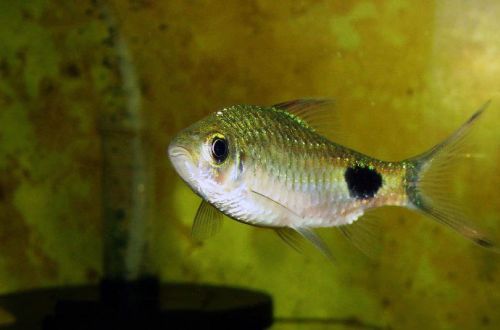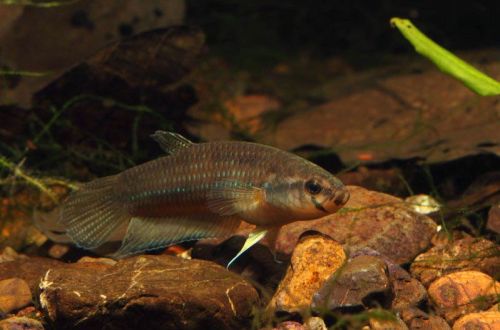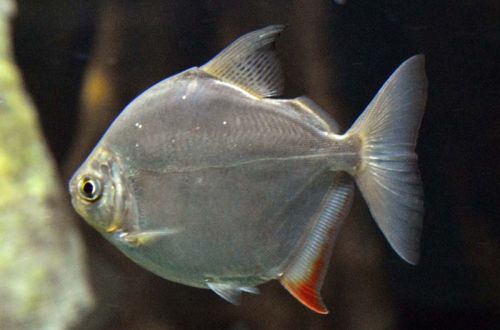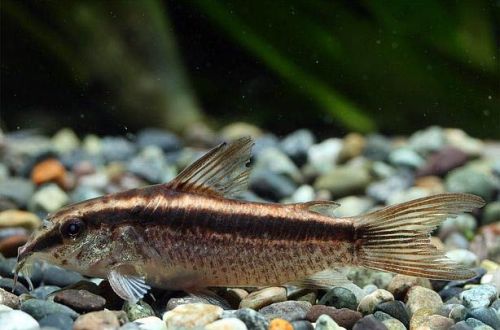
barbus filamentosus
Barbus filamentosus, scientific name Dawkinsia filamentosa, belongs to the Cyprinidae family. An active schooling fish compatible with many other popular aquarium species. It is easy to keep and breed, so it can be recommended for beginner aquarists.

Contents
Habitat
The natural range is limited to the southern tip of the Hindustan peninsula along the Western Ghats mountain range, which is on the territory of the modern states of Kerala, Tamil Nadu and Karnataka of the Republic of India. It lives mainly in shallow flat coastal floodplains of rivers and swamps, which are often infiltrated by salt water from the ocean.
Description
A fairly large representative of cyprinids, adults reach a length of about 12 cm. Males are smaller than females, but they are distinguished by a more saturated color and an unusual dorsal fin. In adults, the rays of the fin are strongly elongated and somewhat resemble threads. In addition, during the spawning period, small growths in the form of tubercles appear on the head in the mouth area. The body is silvery with a large dark spot at the base of the tail, the tips of which often have a red stroke.
Food
An omnivorous species, it will accept all types of dry, frozen and live food. The main condition is that the diet should be varied. A balanced diet may look like a combination of flakes or granules with bloodworms, daphnia, small worms, both live and frozen. Feed 2-3 times a day in the amount eaten in 5 minutes, food debris should be removed.
Maintenance and care, arrangement of the aquarium
A tank of 250 liters will be quite sufficient for a small flock of fish. The decoration uses: stones, boulders, sand as a substrate, a few snags, roots and / or branches of trees for shelter, as well as groups of unpretentious plants, such as mosses and ferns, anubias.
Water quality is critical, Barbus filamentosus does not tolerate pollution by organic and other waste, so special attention should be paid to the filtration system and timely water changes, which are done at least once a week in a volume of 30–50% of the tank size. Another important aspect is the content of dissolved oxygen. It is necessary to use several spray stones located in different places in the tank.
There is no need to use brackish water unless your fish has been kept in similar conditions before. A freshwater aquarium would be the best option.
Behavior and Compatibility
A flocking species, prefers to stay in a group of 8-10 individuals. It is distinguished by high mobility, but all activity is usually directed at relatives, so Barbus does not bother other neighbors in the aquarium. It is friendly to other fish of similar size and temperament, however, despite its peacefulness, it cannot be kept together with very small fish, they can be perceived as food.
Breeding / breeding
Refers to spawning species. In a home aquarium, spawning can occur at any time of the year. Females throw eggs into the water, and males at this moment fertilize it, then the eggs are left to themselves. Barbs have poorly developed parental instincts, so they can eat their own caviar immediately after spawning.
If there is a need to preserve offspring, then it is more expedient to breed in a separate tank – a spawning aquarium. It uses coarse ground with large spaces between particles, such as pebbles, decorative glass beads. Eggs fall into these voids and thus become inaccessible for eating. As protection, you can also use a fine mesh grid over the ground. Any plants, other decoration is usually not required. Of the equipment, a heater, an aerator, a low-power lamp and a simple sponge filter should be used. It is filled with water from the general aquarium.
When you notice that the females are noticeably rounded, and the males have characteristic light tubercles on their heads, then the mating season has begun. This female and one of the two strongest males are moved to a spawning aquarium. At the end of spawning, the fish are returned back.
The fry appear after 24–28 hours, and begin to swim freely after another day. Feed with specialized microfood, which is recommended to be purchased at pet stores.
Fish diseases
A balanced aquarium ecosystem with suitable conditions for a particular species and proper nutrition are the best guarantee against the occurrence of various kinds of diseases. Diseases, as a rule, are only a consequence of an unsatisfactory state of the environment, and this must be dealt with first of all. However, it is also useful to know the treatment methods and symptoms of common diseases, more about them in the section “Diseases of aquarium fish”.





